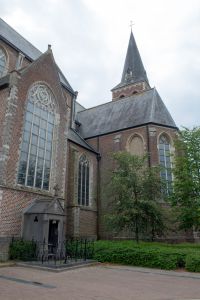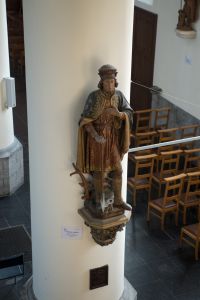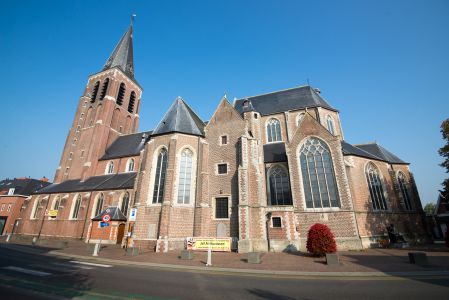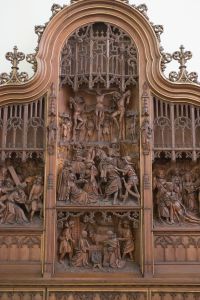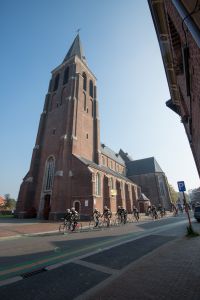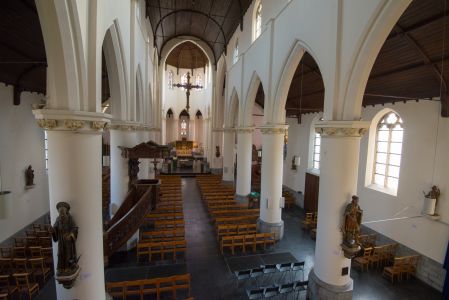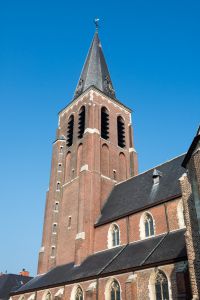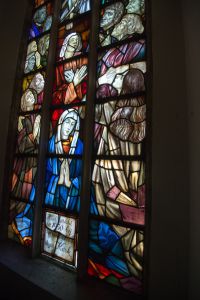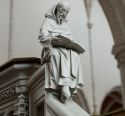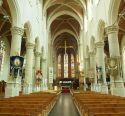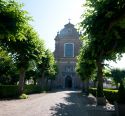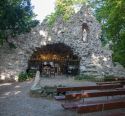Church | XV | Gothic | Catholic Church

Map
Opening hours
01 June - 31 July
Mon -
Tue 13.00 - 17.00
Wed -
Thu -
Fri -
Sat 13.00 - 17.00
Sun 13.00 - 17.00
Tuesday and Saturday, after telephone call (tel. number in the portal).
Guided tour
+32 3 660 28 30![]()
Religious offices
Description
The old church, tracing back to the 13th-14th century, was demolished and replaced by the present church in the 15th century. According to records, the building of the tower was started in 1422. The nave was added in the period 1436-1440, and in 1486 work started on the chancel.
Fire and war at the end of the 16th century and several renovations left their mark. Especially the Second World War caused a lot of damage. The 15th century tower was completely destroyed and part of the nave was reduced to rubble. The church was restored in 1948-1949.
The imposing cruciform basilica was erected in so-called Kempen (local) gothic style. The chancel and its surroundings are clearly raised. The interior has a wooden round arch vault ceiling and stucco painted walls.
The altar piece, depicting the Passion of Christ, is a copy of the one in the church of Hulsthout. The side panels are dedicated to St. George. Some statues, like that of Saint Michael (1764), date from the 17th and 18th century. The oak pulpit dates from around 1780. The confessionals are in neo-gothic style.Noteworthy are the tombstones from the 17th, 18th and 19th century.
The Latin College, opened in 1515, put Brecht on the cultural map and became a centre of Humanism. Well-known humanists Gabriel Mudaeus (lawyer) and Leonardus Lessius (theologian) attended this institute. A statue of the former stands near the neo-gothic village hall and a modern sculpture of the latter was placed near the church.
This cultural peak period was short lived as the village was almost completely destroyed during the Reformation wars (1575-1584) by the Spanish troops. Brecht remained uninhabited for many years and only slowly recovered during the 18th and 19th centuries.
KIKIRPA : Photo-library online
Information about the church and routes nearby (NL)
Photos
Remarkable elements
Painting “De Lansstoot”
This painting, know as ‘The stab of the lance’, was copied in 1640 by Jacob Nieuwlants after an example from P.P. Rubens.The pulpit
The pulpit in Louis XVI style dates back to 1789-1790. It was carried out in oakwood by cabinetmaker Cornelis van Roey and sculptor Geeraert De Haen. The three godly virtues are chiseled onto the sound board: faith (a cross), hope (an anchor) and love (a heart).The holy Cross Altar
The Holy Cross Altar (in the right side aisle) was made by Jan Gerrits. A Gothic retable is displayed on the top of the altar. The side panels were painted by Goeswijn Van Der Weyden and date back to 1490. They are also painted on the inside; the paintings depict events from the Saint-George legend.Originally the side panels were attached to the Saint-George altar. The Saint-George guild probably had the altar built at the end of the 15th century. The Saint-George guild, or written in full ‘’the guild of the noble knight Saint-George in Brecht’,’ already existed in the 14th century. Their weapon is the crossbow. Every three year they shoot on the vertical stake to crown a new king.



